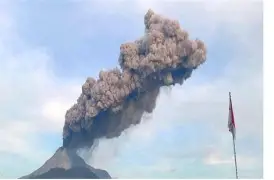Table of Contents
Mount Lewotobi Laki-Laki, an active stratovolcano in Southeast Indonesia, erupted violently on Monday, sending a towering ash plume over 8,000 meters into the sky and triggering mass evacuations. The sudden volcanic activity has affected air traffic and raised fears of a potential humanitarian crisis. As rescue operations intensify and local authorities issue red alerts, the Mount Lewotobi eruption marks another stark reminder of the region’s volatile geology.
Mount Lewotobi Laki-Laki: Sudden Eruption Sends Ash Skyward
Located on Flores Island in East Nusa Tenggara, Mount Lewotobi Laki-Laki erupted in the early hours, spewing lava, toxic gases, and volcanic ash across surrounding villages. The Volcanology and Geological Disaster Mitigation Center (PVMBG) upgraded the alert level to the highest Tier IV.
Over 2,500 residents have been evacuated from high-risk zones within a 6-kilometer radius. Visibility has dropped drastically in nearby towns, and volcanic tremors continue to rattle the region.
“This is the most powerful eruption in over a decade,” said Dr. Agus Supriyanto, head of Indonesia’s Geological Agency. “We are monitoring seismic activity closely.”
Flight Disruptions and Air Quality Warnings Issue
The ash cloud has disrupted flights across eastern Indonesia, prompting multiple airport closures and flight reroutes, especially in Kupang, Ende, and Maumere.
AirNav Indonesia issued aviation alerts to regional carriers and international airlines operating in the vicinity. Passengers are advised to check with airlines before traveling.
Meanwhile, the Indonesian Ministry of Health has warned residents to wear N95 masks and avoid prolonged outdoor exposure, citing dangerous levels of sulfur dioxide and ash in the air.
Volcanic Activity in the Pacific Ring of Fire
Mount Lewotobi lies within the Pacific Ring of Fire, a region prone to earthquakes and volcanic eruptions. Indonesia is home to over 120 active volcanoes, making it one of the most seismically active nations on Earth.
The eruption of Mount Lewotobi comes just months after similar activity from Mount Semeru and Mount Marapi, suggesting a period of heightened geological instability across Southeast Asia.
Volcanologists warn that increased magma pressure may lead to further eruptions in neighboring regions if tectonic activity persists.
Implications / Why It Matters
The Lewotobi eruption is not just a local disaster—it has global implications. Keywords like “Mount Lewotobi eruption,” “Indonesia volcano today,” and “Pacific Ring of Fire activity” are now trending worldwide.
Beyond aviation and health risks, the eruption could impact agriculture, water safety, and international climate patterns if ash reaches the stratosphere.
Disaster relief agencies including ASEAN AHA Centre and UN OCHA are preparing emergency responses. Global readers are reminded of the need for early-warning systems, investment in resilient infrastructure, and greater awareness of climate-related geological hazards.


